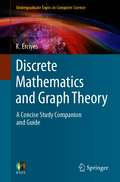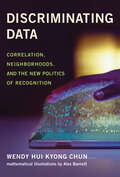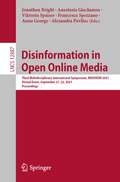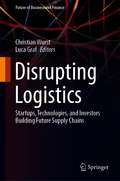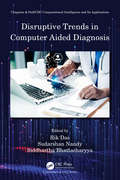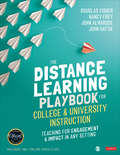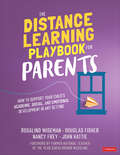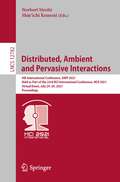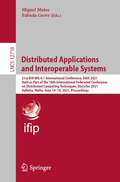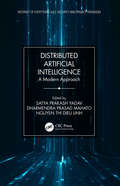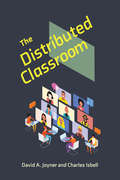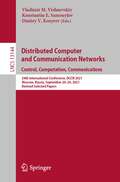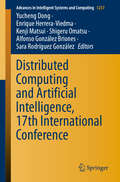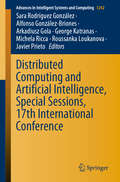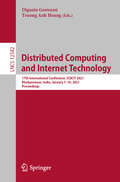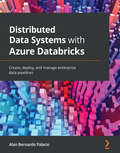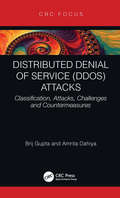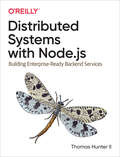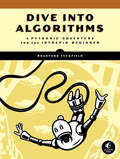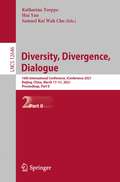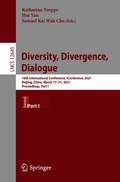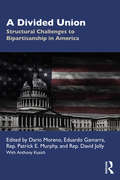- Table View
- List View
Discrete Mathematics and Graph Theory: A Concise Study Companion and Guide (Undergraduate Topics in Computer Science)
by K. ErciyesThis textbook can serve as a comprehensive manual of discrete mathematics and graph theory for non-Computer Science majors; as a reference and study aid for professionals and researchers who have not taken any discrete math course before. It can also be used as a reference book for a course on Discrete Mathematics in Computer Science or Mathematics curricula. The study of discrete mathematics is one of the first courses on curricula in various disciplines such as Computer Science, Mathematics and Engineering education practices. Graphs are key data structures used to represent networks, chemical structures, games etc. and are increasingly used more in various applications such as bioinformatics and the Internet. Graph theory has gone through an unprecedented growth in the last few decades both in terms of theory and implementations; hence it deserves a thorough treatment which is not adequately found in any other contemporary books on discrete mathematics, whereas about 40% of this textbook is devoted to graph theory. The text follows an algorithmic approach for discrete mathematics and graph problems where applicable, to reinforce learning and to show how to implement the concepts in real-world applications.
Discriminating Data: Correlation, Neighborhoods, and the New Politics of Recognition
by Wendy Hui ChunHow big data and machine learning encode discrimination and create agitated clusters of comforting rage.In Discriminating Data, Wendy Hui Kyong Chun reveals how polarization is a goal—not an error—within big data and machine learning. These methods, she argues, encode segregation, eugenics, and identity politics through their default assumptions and conditions. Correlation, which grounds big data&’s predictive potential, stems from twentieth-century eugenic attempts to &“breed&” a better future. Recommender systems foster angry clusters of sameness through homophily. Users are &“trained&” to become authentically predictable via a politics and technology of recognition. Machine learning and data analytics thus seek to disrupt the future by making disruption impossible. Chun, who has a background in systems design engineering as well as media studies and cultural theory, explains that although machine learning algorithms may not officially include race as a category, they embed whiteness as a default. Facial recognition technology, for example, relies on the faces of Hollywood celebrities and university undergraduates—groups not famous for their diversity. Homophily emerged as a concept to describe white U.S. resident attitudes to living in biracial yet segregated public housing. Predictive policing technology deploys models trained on studies of predominantly underserved neighborhoods. Trained on selected and often discriminatory or dirty data, these algorithms are only validated if they mirror this data. How can we release ourselves from the vice-like grip of discriminatory data? Chun calls for alternative algorithms, defaults, and interdisciplinary coalitions in order to desegregate networks and foster a more democratic big data.
Disinformation in Open Online Media: Third Multidisciplinary International Symposium, MISDOOM 2021, Virtual Event, September 21–22, 2021, Proceedings (Lecture Notes in Computer Science #12887)
by Jonathan Bright Anastasia Giachanou Viktoria Spaiser Francesca Spezzano Anna George Alexandra PavliucThis book constitutes the refereed proceedings of the Third Multidisciplinary International Symposium on Disinformation in Open Online Media, MISDOOM 2021, held in September 2021. The conference was held virtually due to the COVID-19 pandemic. The 9 full papers were carefully reviewed and selected from 27 submissions. The papers focus on health misinformation, hate speech, misinformation diffusion, news spreading behaviour and mitigation, harm-aware news recommender systems.
Dispositifs Formidables (Comment faire... #28)
by Owen JonesDispositifs Formidables Quelques dispositifs rétro pour le mec sympa Les articles de ce livre électronique sont des suggestions et des conseils sur les dispositifs, les outils intéressants pour les adultes et d'autres sujets similaires, mais le livre doit être considéré comme un tout. Le texte est composé à plusieurs niveaux : j'espère que vous trouverez ses informations utiles, et en outre, en l'achetant, vous pourrez également utiliser son contenu dans vos propres publications.
Disrupting Logistics: Startups, Technologies, and Investors Building Future Supply Chains (Future of Business and Finance)
by Christian Wurst Luca GrafThis book presents trends, developments, and examples of how digital disruption is currently reshaping the logistics industry. Logistics is the invisible force behind the global economy, influencing and providing a lens into all economic activities. Chapters written by respected experts in the field describe how new technologies such as autonomous vehicles, blockchain, Internet of things (IoT), and state-of-the-art freight management solutions are fundamentally changing supply chain solutions. Special emphasis is placed on promising start-ups and venture capital firms around the world that are now investing in the future of logistics."Supply chains hold significant room for optimization to the benefit of customers, industry participants, authorities and the environment. This book provides a unique set of perspectives from industry leaders covering a wide range of topics. It is a ‘must read’ for anyone seeking to understand and contribute to a better tomorrow in supply chains logistics." — Thomas Bagge, Chief Executive Officer and Statutory Director DCSA“The need for standardisation and digitalisation in logistics is no longer an option. This book gives insights from industry experts, shows trends and innovations in platforms, underlines the need for transparency and how big data and analytics can make a world of difference. It’s an incredible resource if you wish to better understand the new normal of logistics.” — Global Chief Digital & Information Officer, MSC Mediterranean Shipping Company"This book presents readers with a straightforward and comprehensive assessment of supply chain innovation and trends and their impact on the industry. With contributions from several industry leaders, it provides critical knowledge and insight that supply chain and logistics managers need to implement disruptive technologies strategically.” — Rene Jacquat, Founder / Advisor, LogiChain Solutions
Disruptive Trends in Computer Aided Diagnosis (Chapman & Hall/CRC Computational Intelligence and Its Applications)
by Rik DasDisruptive Trends in Computer Aided Diagnosis collates novel techniques and methodologies in the domain of content based image classification and deep learning/machine learning techniques to design efficient computer aided diagnosis architecture. It is aimed to highlight new challenges and probable solutions in the domain of computer aided diagnosis to leverage balancing of sustainable ecology. The volume focuses on designing efficient algorithms for proposing CAD systems to mitigate the challenges of critical illnesses at an early stage. State-of-the-art novel methods are explored for envisaging automated diagnosis systems thereby overriding the limitations due to lack of training data, sample annotation, region of interest identification, proper segmentation and so on. The assorted techniques addresses the challenges encountered in existing systems thereby facilitating accurate patient healthcare and diagnosis. Features: An integrated interdisciplinary approach to address complex computer aided diagnosis problems and limitations. Elucidates a rich summary of the state-of-the-art tools and techniques related to automated detection and diagnosis of life threatening diseases including pandemics. Machine learning and deep learning methodologies on evolving accurate and precise early detection and medical diagnosis systems. Information presented in an accessible way for students, researchers and medical practitioners. The volume would come to the benefit of both post-graduate students and aspiring researchers in the field of medical informatics, computer science and electronics and communication engineering. In addition, the volume is also intended to serve as a guiding factor for the medical practitioners and radiologists in accurate diagnosis of diseases.
The Distance Learning Playbook for College and University Instruction: Teaching for Engagement and Impact in Any Setting
by Douglas Fisher Nancy Frey John T. Almarode John HattieFirst, let’s commend ourselves: how in the midst of a pandemic we faculty stepped up at record speed to teach in such a foreign learning environment. Try we did, adapt we did, and learn we did. But to be clear, and we already recognize this, this past spring was less about distance learning and more about crisis teaching. This time around we have the opportunity to be much more purposeful and intentional, and that’s where The Distance Learning Playbook for College and University Instruction will prove absolutely indispensable. Much more than a collection of cool tools and apps, The Distance Learning Playbook for College and University Instruction mobilizes decades of Visible Learning® research to reveal those evidence-based strategies that work best in an online environment. Supplemented by video footage and opportunities to self-assess and reflect, the book addresses every dynamic that must be in place for students to learn, even at a distance: Faculty-student relationships from a distance Teacher credibility from a distance Teacher clarity from a distance Engaging tasks from a distance Planning learning experiences from a distance Feedback, assessment, and grading from a distance Keeping the focus on learning, from a distance or otherwise What does our post-COVID future hold? "We suspect," Fisher, Frey, Almarode, and Hattie write, "it will include increased amounts of distance learning. In the meantime, let’s seize on what we have learned to improve post-secondary education in any format, whether face-to-face or from a distance." "We are all still active faculty members, committed to teaching, scholarship, and service. The unexpected transition to remote learning doesn’t mean we no longer know how to teach. We can still impact the lives of our students and know that we made a difference. The Distance Learning Playbook for College and University Instruction will show you how." ~Douglas Fisher, Nancy Frey, John Almarode, and John Hattie
The Distance Learning Playbook for College and University Instruction: Teaching for Engagement and Impact in Any Setting
by Douglas Fisher Nancy Frey John T. Almarode John HattieFirst, let’s commend ourselves: how in the midst of a pandemic we faculty stepped up at record speed to teach in such a foreign learning environment. Try we did, adapt we did, and learn we did. But to be clear, and we already recognize this, this past spring was less about distance learning and more about crisis teaching. This time around we have the opportunity to be much more purposeful and intentional, and that’s where The Distance Learning Playbook for College and University Instruction will prove absolutely indispensable. Much more than a collection of cool tools and apps, The Distance Learning Playbook for College and University Instruction mobilizes decades of Visible Learning® research to reveal those evidence-based strategies that work best in an online environment. Supplemented by video footage and opportunities to self-assess and reflect, the book addresses every dynamic that must be in place for students to learn, even at a distance: Faculty-student relationships from a distance Teacher credibility from a distance Teacher clarity from a distance Engaging tasks from a distance Planning learning experiences from a distance Feedback, assessment, and grading from a distance Keeping the focus on learning, from a distance or otherwise What does our post-COVID future hold? "We suspect," Fisher, Frey, Almarode, and Hattie write, "it will include increased amounts of distance learning. In the meantime, let’s seize on what we have learned to improve post-secondary education in any format, whether face-to-face or from a distance." "We are all still active faculty members, committed to teaching, scholarship, and service. The unexpected transition to remote learning doesn’t mean we no longer know how to teach. We can still impact the lives of our students and know that we made a difference. The Distance Learning Playbook for College and University Instruction will show you how." ~Douglas Fisher, Nancy Frey, John Almarode, and John Hattie
The Distance Learning Playbook for Parents: How to Support Your Child′s Academic, Social, and Emotional Development in Any Setting
by Rosalind Wiseman Douglas Fisher Nancy Frey John HattieWe are in this together and will get through this together Parent involvement has always been a vital part of any child’s education, but the pandemic and resulting remote instruction require that parents and educators partner at a deeper level. Following the tremendous success of The Distance Learning Playbook, K-12, education authorities Doug Fisher, Nancy Frey, and John Hattie have teamed up with New York Times bestselling author and parenting expert Rosalind Wiseman to bring you the consummate guide to support your child′s academic, social, and emotional development in any learning environment – while not overwhelming you in the process. This essential guide will arm you with the tools and insight to Create an environment conducive to learning, establish routines, and most importantly, take care of yourself and your child Maximize the time you spend supporting learning by focusing on what is proven to work best in education Help your child develop the cognitive attitudes and habits that foster creativity, critical thinking, and increased responsibility for their learning Support the development of your child’s social and emotional learning skills, including the ability to navigate social interactions, build friendships, and regulate emotions at a time when they have never been more important to have, and more challenging to maintain The Distance Learning Playbook for Parents outlines supportive strategies for navigating virtual environments to ensure effective and impactful learning that aligns the needs and expectations of teachers, parents, and students alike.
The Distance Learning Playbook for Parents: How to Support Your Child′s Academic, Social, and Emotional Development in Any Setting
by Rosalind Wiseman Douglas Fisher Nancy Frey John HattieWe are in this together and will get through this together Parent involvement has always been a vital part of any child’s education, but the pandemic and resulting remote instruction require that parents and educators partner at a deeper level. Following the tremendous success of The Distance Learning Playbook, K-12, education authorities Doug Fisher, Nancy Frey, and John Hattie have teamed up with New York Times bestselling author and parenting expert Rosalind Wiseman to bring you the consummate guide to support your child′s academic, social, and emotional development in any learning environment – while not overwhelming you in the process. This essential guide will arm you with the tools and insight to Create an environment conducive to learning, establish routines, and most importantly, take care of yourself and your child Maximize the time you spend supporting learning by focusing on what is proven to work best in education Help your child develop the cognitive attitudes and habits that foster creativity, critical thinking, and increased responsibility for their learning Support the development of your child’s social and emotional learning skills, including the ability to navigate social interactions, build friendships, and regulate emotions at a time when they have never been more important to have, and more challenging to maintain The Distance Learning Playbook for Parents outlines supportive strategies for navigating virtual environments to ensure effective and impactful learning that aligns the needs and expectations of teachers, parents, and students alike.
Distributed, Ambient and Pervasive Interactions: 9th International Conference, DAPI 2021, Held as Part of the 23rd HCI International Conference, HCII 2021, Virtual Event, July 24–29, 2021, Proceedings (Lecture Notes in Computer Science #12782)
by Norbert Streitz Shin’ichi KonomiThis conference proceedings LNCS 12782 constitutes the refereed proceedings of the 9 th International Conference on Distributed, Ambient and Pervasive Interactions, DAPI 2021, held as part of the 23rd International Conference, HCI International 2021, which took place in July 2021. The conference was held virtually due to the COVID-19 pandemic.The total of 1276 papers and 241 posters included in the 39 HCII 2021 proceedings volumes was carefully reviewed and selected from 5222 submissions. The papers of DAPI 2021, Distributed, Ambient and Pervasive Interactions, are organized in topical sections named: Smart Cities; IoT, Sensors and Smart Environments; Learning and Culture in Intelligent Environments; Designing Intelligent Environments.
Distributed Applications and Interoperable Systems: 21st IFIP WG 6.1 International Conference, DAIS 2021, Held as Part of the 16th International Federated Conference on Distributed Computing Techniques, DisCoTec 2021, Valletta, Malta, June 14–18, 2021, Proceedings (Lecture Notes in Computer Science #12718)
by Miguel Matos Fabíola GreveThis book constitutes the refereed proceedings of the 21st IFIP WG 6.1 International Conference on Distributed Applications and Interoperable Systems, DAIS 2021, held in Valletta, Malta, in June 2021, as part of the 16th International Federated Conference on Distributed Computing Techniques, DisCoTec 2021. The 7 regular papers and 3 short papers presented in this book were carefully reviewed and selected from 15 submissions. DAIS addresses all practical and conceptual aspects of distributed applications, including their design, modeling, implementation and operation, the supporting middleware, appropriate software engineering methodologies and tools, as well as experimental studies and applications.
Distributed Artificial Intelligence: A Modern Approach (Internet of Everything (IoE))
by Satya Prakash Yadav, Dharmendra Prasad Mahato, and Nguyen Thi Dieu LinhDistributed Artificial Intelligence (DAI) came to existence as an approach for solving complex learning, planning, and decision-making problems. When we talk about decision making, there may be some meta-heuristic methods where the problem solving may resemble like operation research. But exactly, it is not related completely to management research. The text examines representing and using organizational knowledge in DAI systems, dynamics of computational ecosystems, and communication-free interactions among rational agents. This publication takes a look at conflict-resolution strategies for nonhierarchical distributed agents, constraint-directed negotiation of resource allocations, and plans for multiple agents. Topics included plan verification, generation, and execution, negotiation operators, representation, network management problem, and conflict-resolution paradigms. The manuscript elaborates on negotiating task decomposition and allocation using partial global planning and mechanisms for assessing nonlocal impact of local decisions in distributed planning. The book will attract researchers and practitioners who are working in management and computer science, and industry persons in need of a beginner to advanced understanding of the basic and advanced concepts.
The Distributed Classroom (Learning in Large-Scale Environments)
by David Joyner Charles IsbellA vision of the future of education in which the classroom experience is distributed across space and time without compromising learning.What if there were a model for learning in which the classroom experience was distributed across space and time--and students could still have the benefits of the traditional classroom, even if they can't be present physically or learn synchronously? In this book, two experts in online learning envision a future in which education from kindergarten through graduate school need not be tethered to a single physical classroom. The distributed classroom would neither sacrifice students' social learning experience nor require massive development resources. It goes beyond hybrid learning, so ubiquitous during the COVID-19 pandemic, and MOOCs, so trendy a few years ago, to reimagine the classroom itself. David Joyner and Charles Isbell, both of Georgia Tech, explain how recent developments, including distance learning and learning management systems, have paved the way for the distributed classroom. They propose that we dispense with the dichotomy between online and traditional education, and the assumption that online learning is necessarily inferior. They describe the distributed classroom's various delivery modes for in-person students, remote synchronous students, and remote asynchronous students; the goal would be a symmetry of experiences, with both students and teachers able to move from one mode to another. With The Distributed Classroom, Joyner and Isbell offer an optimistic, learner-centric view of the future of education, in which every person on earth is turned into a potential learner as barriers of cost, geography, and synchronicity disappear.
Distributed Computer and Communication Networks: 24th International Conference, DCCN 2021, Moscow, Russia, September 20–24, 2021, Revised Selected Papers (Lecture Notes in Computer Science #13144)
by Vladimir M. Vishnevskiy Konstantin E. Samouylov Dmitry V. KozyrevThis book constitutes the refereed post-conference proceedings of the 24th International Conference on Distributed and Computer and Communication Networks, DCCN 2021, held in Moscow, Russia, in September 2021. The 26 revised full papers and 3 revised short papers were carefully reviewed and selected from 151 submissions. The papers cover the following topics: computer and communication networks; analytical modeling of distributed systems; and distributed systems applications.
Distributed Computing and Artificial Intelligence, 17th International Conference (Advances in Intelligent Systems and Computing #1237)
by Yucheng Dong Enrique Herrera-Viedma Kenji Matsui Shigeru Omatsu Alfonso González Briones Sara Rodríguez GonzálezThis book brings together past experience, current work and promising future trends associated with distributed computing, artificial intelligence and their application in order to provide efficient solutions to real problems. DCAI 2020 is a forum to present applications of innovative techniques for studying and solving complex problems in artificial intelligence and computing areas. This year’s technical program will present both high quality and diversity, with contributions in well-established and evolving areas of research. Specifically, 83 papers were submitted to main track and special sessions, by authors from 26 different countries representing a truly “wide area network” of research activity. The DCAI’20 technical program has selected 35 papers and, as in past editions, it will be special issues in ranked journals. This symposium is organized by the University of L'Aquila (Italy). We would like to thank all the contributing authors, the members of the Program Committee and the sponsors (IBM, Armundia Group, EurAI, AEPIA, APPIA, CINI, OIT, UGR, HU, SCU, USAL, AIR Institute and UNIVAQ).
Distributed Computing and Artificial Intelligence, Special Sessions, 17th International Conference (Advances in Intelligent Systems and Computing #1242)
by Javier Prieto Alfonso González-Briones Roussanka Loukanova Sara Rodríguez González Arkadiusz Gola George Katranas Michela RiccaThis book brings together past insights, current research and promising future trends associated with distributed computing, artificial intelligence and their application in order to provide efficient solutions to real-world problems. The book is based on the International Conference on Distributed Computing and Artificial Intelligence 2020 (DCAI 2020), which provided a forum to present applications of innovative techniques for studying and solving complex problems in artificial intelligence and computing areas. It includes contributions on well-established and evolving areas of research, by authors from 26 countries, representing a truly “wide area network” of research activity
Distributed Computing and Internet Technology: 17th International Conference, ICDCIT 2021, Bhubaneswar, India, January 7–10, 2021, Proceedings (Lecture Notes in Computer Science #12582)
by Diganta Goswami Truong Anh HoangThis book constitutes the proceedings of the 17th International Conference on Distributed Computing and Internet Technology, ICDCIT 2020, held in Bhubaneswar, India, in January 2021. The 13 full papers presented together with 4 short papers were carefully reviewed and selected from 99 submissions. The papers were organized in topical sections named: invited talks, cloud computing and networks, distributed algorithms, concurrency and parallelism, graph algorithms and security, social networks and machine learning, and short papers.
Distributed Data Systems with Azure Databricks: Create, deploy, and manage enterprise data pipelines
by Alan Bernardo PalacioQuickly build and deploy massive data pipelines and improve productivity using Azure DatabricksKey FeaturesGet to grips with the distributed training and deployment of machine learning and deep learning modelsLearn how ETLs are integrated with Azure Data Factory and Delta LakeExplore deep learning and machine learning models in a distributed computing infrastructureBook DescriptionMicrosoft Azure Databricks helps you to harness the power of distributed computing and apply it to create robust data pipelines, along with training and deploying machine learning and deep learning models. Databricks' advanced features enable developers to process, transform, and explore data. Distributed Data Systems with Azure Databricks will help you to put your knowledge of Databricks to work to create big data pipelines. The book provides a hands-on approach to implementing Azure Databricks and its associated methodologies that will make you productive in no time. Complete with detailed explanations of essential concepts, practical examples, and self-assessment questions, you'll begin with a quick introduction to Databricks core functionalities, before performing distributed model training and inference using TensorFlow and Spark MLlib. As you advance, you'll explore MLflow Model Serving on Azure Databricks and implement distributed training pipelines using HorovodRunner in Databricks. Finally, you'll discover how to transform, use, and obtain insights from massive amounts of data to train predictive models and create entire fully working data pipelines. By the end of this MS Azure book, you'll have gained a solid understanding of how to work with Databricks to create and manage an entire big data pipeline.What you will learnCreate ETLs for big data in Azure DatabricksTrain, manage, and deploy machine learning and deep learning modelsIntegrate Databricks with Azure Data Factory for extract, transform, load (ETL) pipeline creationDiscover how to use Horovod for distributed deep learningFind out how to use Delta Engine to query and process data from Delta LakeUnderstand how to use Data Factory in combination with DatabricksUse Structured Streaming in a production-like environmentWho this book is forThis book is for software engineers, machine learning engineers, data scientists, and data engineers who are new to Azure Databricks and want to build high-quality data pipelines without worrying about infrastructure. Knowledge of Azure Databricks basics is required to learn the concepts covered in this book more effectively. A basic understanding of machine learning concepts and beginner-level Python programming knowledge is also recommended.
Distributed Denial of Service (DDoS) Attacks: Classification, Attacks, Challenges and Countermeasures
by Brij B. Gupta Amrita DahiyaThe complexity and severity of the Distributed Denial of Service (DDoS) attacks are increasing day-by-day. The Internet has a highly inconsistent structure in terms of resource distribution. Numerous technical solutions are available, but those involving economic aspects have not been given much consideration. The book, DDoS Attacks – Classification, Attacks, Challenges, and Countermeasures, provides an overview of both types of defensive solutions proposed so far, exploring different dimensions that would mitigate the DDoS effectively and show the implications associated with them. Features: Covers topics that describe taxonomies of the DDoS attacks in detail, recent trends and classification of defensive mechanisms on the basis of deployment location, the types of defensive action, and the solutions offering economic incentives. Introduces chapters discussing the various types of DDoS attack associated with different layers of security, an attacker’s motivations, and the importance of incentives and liabilities in any defensive solution. Illustrates the role of fair resource-allocation schemes, separate payment mechanisms for attackers and legitimate users, negotiation models on cost and types of resources, and risk assessments and transfer mechanisms. DDoS Attacks – Classification, Attacks, Challenges, and Countermeasures is designed for the readers who have an interest in the cybersecurity domain, including students and researchers who are exploring different dimensions associated with the DDoS attack, developers and security professionals who are focusing on developing defensive schemes and applications for detecting or mitigating the DDoS attacks, and faculty members across different universities.
Distributed Systems with Node.js
by Thomas Hunter IIMany companies, from startups to Fortune 500 companies alike, use Node.js to build performant backend services. And engineers love Node.js for its approachable API and familiar syntax. Backed by the world's largest package repository, Node's enterprise foothold is only expected to grow.In this hands-on guide, author Thomas Hunter II proves that Node.js is just as capable as traditional enterprise platforms for building services that are observable, scalable, and resilient. Intermediate to advanced Node.js developers will find themselves integrating application code with a breadth of tooling from each layer of a modern service stack.Learn why running redundant copies of the same Node.js service is necessaryKnow which protocol to choose, depending on the situationFine-tune your application containers for use in productionTrack down errors in a distributed setting to determine which service is at faultSimplify app code and increase performance by offloading work to a reverse proxyBuild dashboards to monitor service health and throughputFind out why so many different tools are required when operating in an enterprise environment
Dive Into Algorithms: A Pythonic Adventure for the Intrepid Beginner
by Bradford TuckfieldDive Into Algorithms is a broad introduction to algorithms using the Python Programming Language.Dive Into Algorithms is a wide-ranging, Pythonic tour of many of the world's most interesting algorithms. With little more than a bit of computer programming experience and basic high-school math, you'll explore standard computer science algorithms for searching, sorting, and optimization; human-based algorithms that help us determine how to catch a baseball or eat the right amount at a buffet; and advanced algorithms like ones used in machine learning and artificial intelligence. You'll even explore how ancient Egyptians and Russian peasants used algorithms to multiply numbers, how the ancient Greeks used them to find greatest common divisors, and how Japanese scholars in the age of samurai designed algorithms capable of generating magic squares.You'll explore algorithms that are useful in pure mathematics and learn how mathematical ideas can improve algorithms. You'll learn about an algorithm for generating continued fractions, one for quick calculations of square roots, and another for generating seemingly random sets of numbers.You'll also learn how to: • Use algorithms to debug code, maximize revenue, schedule tasks, and create decision trees • Measure the efficiency and speed of algorithms • Generate Voronoi diagrams for use in various geometric applications • Use algorithms to build a simple chatbot, win at board games, or solve sudoku puzzles • Write code for gradient ascent and descent algorithms that can find the maxima and minima of functions • Use simulated annealing to perform global optimization • Build a decision tree to predict happiness based on a person's characteristicsOnce you've finished this book you'll understand how to code and implement important algorithms as well as how to measure and optimize their performance, all while learning the nitty-gritty details of today's most powerful algorithms.
Diversity, Divergence, Dialogue: 16th International Conference, iConference 2021, Beijing, China, March 17–31, 2021, Proceedings, Part II (Lecture Notes in Computer Science #12646)
by Katharina Toeppe Hui Yan Samuel Kai Wah ChuThis two-volume set LNCS 12645-12646 constitutes the refereed proceedings of the 16th International Conference on Diversity, Divergence, Dialogue, iConference 2021, held in Beijing, China, in March 2021. The 32 full papers and the 59 short papers presented in this two-volume set were carefully reviewed and selected from 225 submissions. They cover topics such as: AI and machine learning; data science; human-computer interaction; social media; digital humanities; education and information literacy; information behavior; information governance and ethics; archives and records; research methods; and institutional management.
Diversity, Divergence, Dialogue: 16th International Conference, iConference 2021, Beijing, China, March 17–31, 2021, Proceedings, Part I (Lecture Notes in Computer Science #12645)
by Katharina Toeppe Hui Yan Samuel Kai Wah ChuThis two-volume set LNCS 12645-12646 constitutes the refereed proceedings of the 16th International Conference on Diversity, Divergence, Dialogue, iConference 2021, held in Beijing, China, in March 2021. The 32 full papers and the 59 short papers presented in this volume were carefully reviewed and selected from 225 submissions. They cover topics such as: AI and machine learning; data science; human-computer interaction; social media; digital humanities; education and information literacy; information behavior; information governance and ethics; archives and records; research methods; and institutional management.
A Divided Union: Structural Challenges to Bipartisanship in America
by Dario Moreno, Eduardo Gamarra, Rep. Patrick E. Murphy, and Rep. David JollyA Divided Union delves deep into ten pressing political challenges that former US Representatives Patrick Murphy (D) and David Jolly (R) have identified over their multiple terms in Congress and that continue to plague the American electorate today. In an introduction describing their unique paths to Congress, Murphy and Jolly focus in detail on key institutional barriers they faced in Washington in attempting to do the job voters elected them to do. They introduce us to geographic challenges, demographic change, a polarized media, gerrymandering, the role of money in politics, the structure of primary elections, and several other aspects of political life on Capitol Hill. The core of the book is original analysis by experts who tackle these topics in a manner relevant to both the seasoned political science student as well as the general reader. From the commercials we see on TV to the city council districts in which we live, these concerns shape every facet of our public lives and are distilled here in a careful synthesis of years of experience and research. Contributors include former federal elected officials, political science professors, members of the press, and scholars immersed in their fields of study. While other textbooks may examine similar issues, few have been edited by former members of the U.S. House who have walked the halls of Congress and directly experienced political dysfunction at so many levels – and are willing to address it. A Divided Union is appropriate for all political science students as well as the general public frustrated and alarmed by political gridlock.
